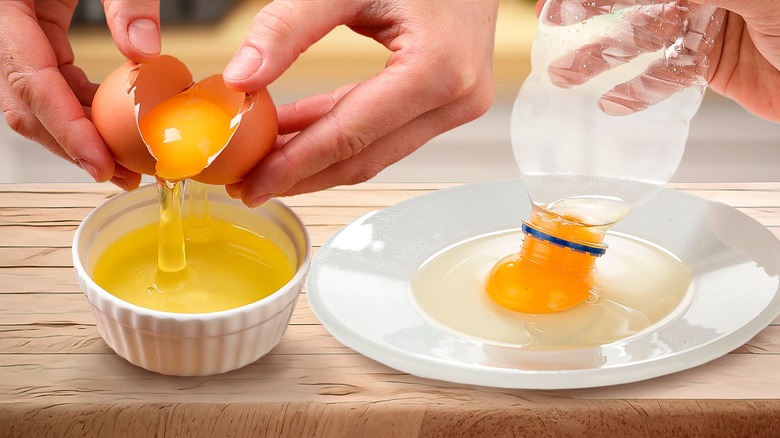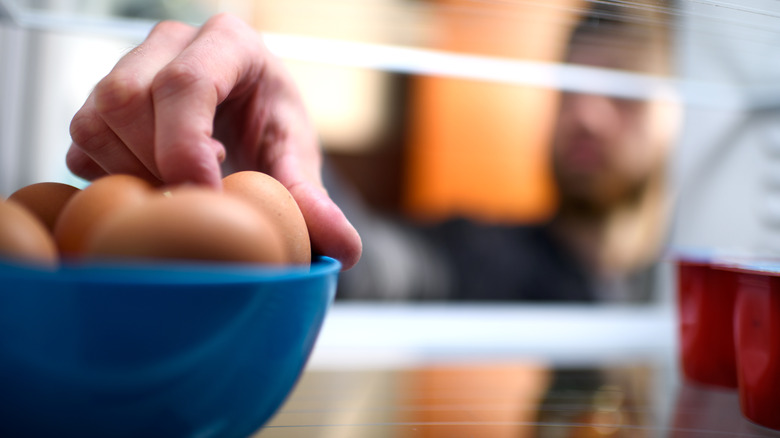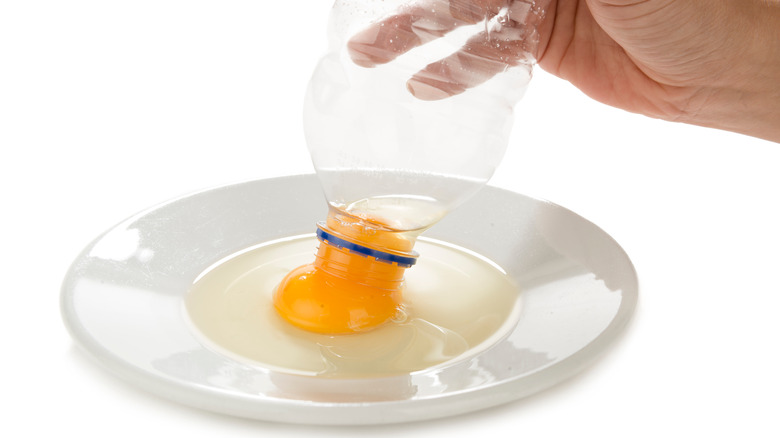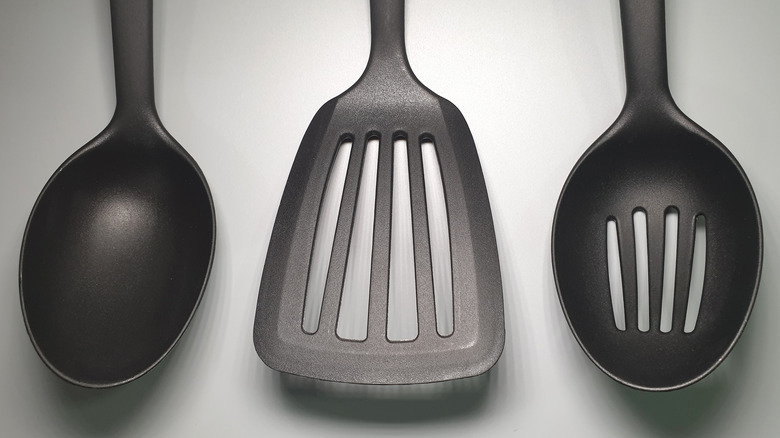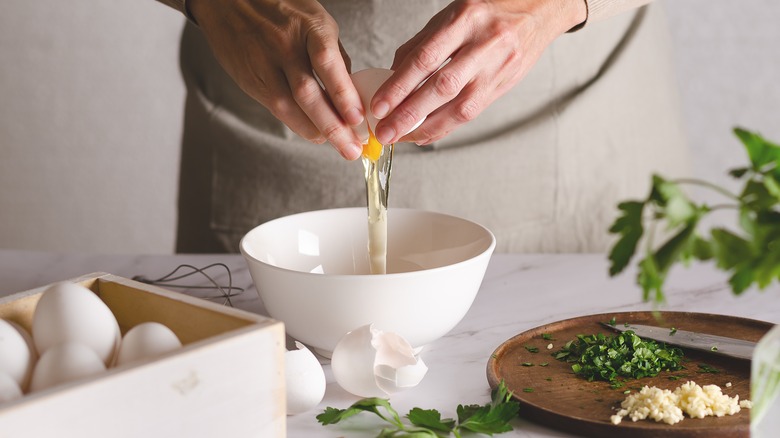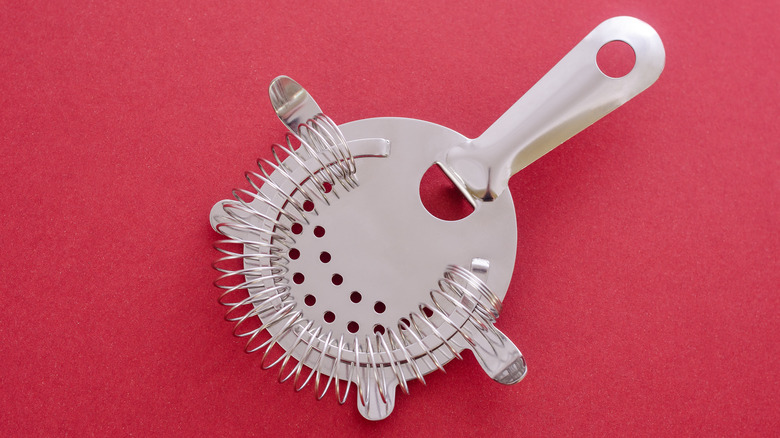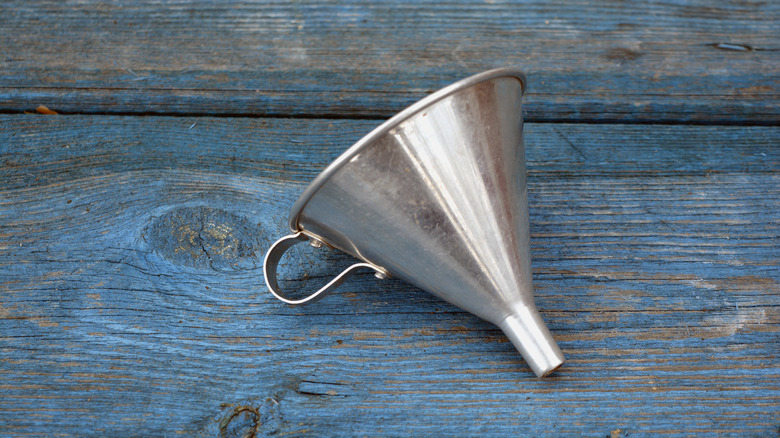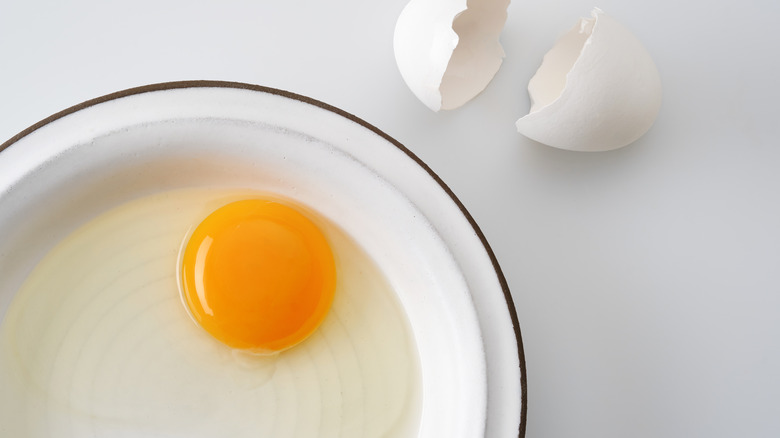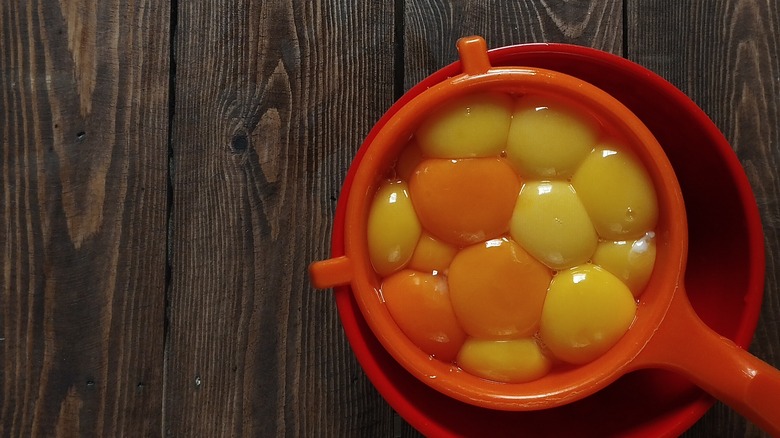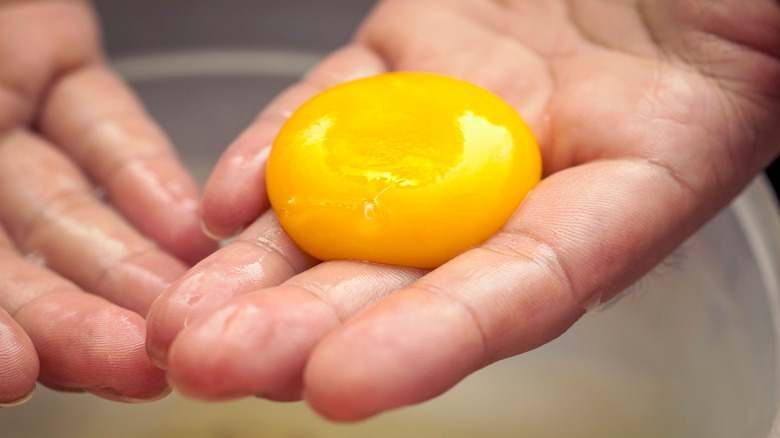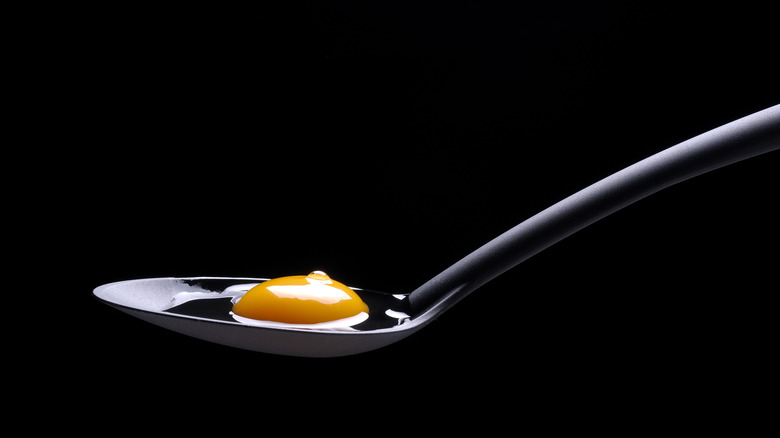11 Hacks That Will Make Separating Eggs So Much Easier
For most of us, cooking and baking means that, sooner or later, we'll need to separate eggs. Maybe you want fluffier pancakes or restaurant-quality waffles. Maybe, you need yolks for a creme brûlée, or whites for a berry Pavlova. You can even delight your kids by separating the whites from the yolks, adding a bit of food coloring to the whites, and then recombining them in the pan once the whites are set (and for grownups, it's a way to nail perfect fried eggs).
The traditional method for separating eggs uses the tool you have right in your hand: the halves of the egg's shell. You simply tip the yolk from shell to shell, shedding some of the whites each time, and then decant the yolk into a second bowl (actually, if you're smart, you'll use three bowls, but most people do it wrong).
The problem with this method is that there are lots of ways to mess it up. You can end up with shell fragments, or break the yolk and get some in your whites (it keeps them from whipping up as they should). Sure, you could buy an egg-separating gadget, but most of us have too many gadgets already (and besides, where's the fun in that?). So here are hacks to help you separate eggs effortlessly, as chosen by a former chef and restaurateur.
1. Keep your eggs cold before separating them
This first hack isn't a method for separating eggs, as such, but a preparatory step. It's a simple and obvious one: keeping your eggs cold before you separate them. At first blush, you might think that's not an issue because most of us refrigerate our eggs, anyway. But bakers know that you shouldn't use cold eggs in a cake, and trying to whip cold egg whites is a common meringue-making mistake. Some even favor room-temperature eggs for frying.
Here's the thing: When eggs are warm, the whites are more liquidy and will slither more easily into the bowl as you separate them, but the yolks are also softer and more fragile. Since breaking the yolks is one of the biggest issues in separating eggs, we find it makes sense to keep them cold and the yolks firm. If your recipe calls for them at room temperature, separate them first and then let them warm.
2. Use an empty water bottle to separate eggs
Using a water bottle to separate eggs is a perennially popular hack on social media. If you tend to click on food-related topics, you can expect any platform's algorithm to put it in front of you regularly.
So does it work? Well, yes: Years ago, when it first started to circulate, we tried it in one of our cooking classes just for fun. First, find a clean, empty water bottle, then break your eggs into a shallow bowl or saucer. Now, squeeze air out of the water bottle, and press it gently to the top of the yolk. Let go of the bottle, and as it springs back into shape, bloop! The yolk is sucked right up into the bottle. Move the bottle to a second bowl, squeeze it again to eject the yolk, and you're done.
Other bottles may work, but the thin, "crinkly" plastic used in many water bottles makes them your best choice. Many companies make suction-type egg separators using the same principle, but the bottle comes free with your water. Kids love to separate eggs with a bottle, by the way, so it's a great way to get them involved in your baking projects.
3. Separate your eggs with a slotted spoon
If you look at the commercial egg-separating gadgets on retail websites, you'll see that most of them fall into two basic styles. Some use suction, the same principle as the water bottle hack. Others have some slots to let the egg whites drip through while holding onto the egg yolk.
Chances are, you already have a handful of utensils in your kitchen that could be used in the same ways. Our favorite is using a slotted spoon to separate eggs because it's usually close to you in the kitchen. You can either crack your eggs one at a time into the spoon, and let the whites drain into your bowl, or crack them all into a shallow bowl and then scoop out the yolks.
If you have a mixing bowl with a pour spout on either side, you may even find that one of your slotted spoons sits neatly in the spout of one side with its handle in the other, so you can separate eggs without needing to hold the spoon (our own perfect bowl went missing, and is still lamented). A flat, wide, skimmer can be used in the same way if you have one.
4. Give yourself sticky fingers with garlic
If you cook with fresh garlic, you'll see that it has a couple of noteworthy characteristics. One is that it's very pungent, with a strong flavor and aroma (that's why we love it!). Another is that its juices are uncommonly sticky. You'll find that chopping fresh garlic is easier if you oil your fingers and knife first, which keeps the juices and garlic pieces from sticking.
But what if you want that stickiness? A popular recent TikTok hack suggests that garlic can save time when separating eggs. Start by cracking your eggs into a bowl, and then rubbing your fingers with garlic. The sticky garlic juices adhere to your fingers, and then you can simply reach into the bowl and pluck the yolks out with your sticky fingertips.
We tested this in the name of culinary science, using a regular supermarket egg and a clove of garlic from last year's garden. It's not our favorite method, because it's limited to dishes where garlic-scented eggs are appropriate, but it does indeed seem to work. Queuing up the Rolling Stones' "Sticky Fingers" album on your playlist while you work is entirely optional.
5. Separate eggs with a cocktail strainer
Cooking and baking aren't the only gastronomic endeavors that might require you to separate eggs. If you're a serious home bartender, you may also need egg whites occasionally to give your cocktails a frothy upgrade.
As it happens, one of the tools you already have at your bar makes a passable egg separator: your cocktail strainer. There are two main kinds, julep strainers, and Hawthorne strainers, and both work fine. The one most of us have, with a coil of wire around the edge, is a Hawthorne strainer; julep strainers look like a small perforated spoon.
In each case, you simply crack an egg into the strainer. The whites will drip through the strainer's slots and holes, leaving the yolk sitting on top of the strainer where you can easily tip it into its own separate bowl. Just remember to wash your strainer really well before using it for that next drink, for food safety reasons.
6. An ordinary kitchen funnel can separate eggs
Do you share Alton Brown's distaste for single-purpose kitchen gadgets, or "unitaskers?" If so, you can definitely file dedicated egg-separating gizmos among those tools you shouldn't waste money on. There are plenty of things already in your kitchen that can do the job.
One of them is a plain old kitchen funnel, something most of us keep on hand. It couldn't be easier to use: Hold the funnel over your bowl, and crack an egg into the top. Your egg whites should drip out the thin end of the funnel, leaving the yolk sitting at the top where you can tip it into a second bowl.
We've done this and can verify that it works, but there are a few details you should know. One is that funnels come in random sizes, so you may need to try a couple before finding one that works. If the yolk falls through your funnel is too large, and if the whites won't drain properly it's too small. You may also find you need to swirl the funnel gently, to move the yolk aside and let the whites drain through.
7. Separate eggs with a saucer and a shot glass
If you have a well-stocked bar, you have tools at your disposal that can make egg-separating easy. One of them is plain old shot glasses. To use this hack, start by cracking your egg onto a saucer or small side plate. Now take a shot glass, turn it upside down, and place it carefully over top of the yolk. Now, put a finger or two on top of the shot glass, to hold it firmly in place, and lift the saucer. Hold the saucer over a bowl and tilt it, and the egg white will slide off the saucer and into the bowl. If your eggs are especially fresh and cold, you may have to give gravity a helping hand by pressing and twisting the shot glass like a cookie cutter, to sever the whites.
You can also use two shot glasses to separate eggs, treating them as a safely consistent alternative to the eggshells. Hold a shot glass over your bowl and crack an egg into it, letting the whites overflow into the bowl. Then tip the yolk into your second shot glass, leaving behind as much of the white as possible. Repeat, until you're left with just the yolk.
8. Use a strainer or colander
Some recipes call for separating eggs in quantity. You might need as few as two egg yolks if you're making classic crème brûlée for yourself and your sweetheart, for example, but in our own home, we make batches of up to two dozen. That's a lot of yolks. You may never make custards at that scale, but other recipes like angel food cake or a party-sized batch of individual cheese soufflés can call for similar quantities of eggs.
Our favorite tool for the job is an ordinary colander or wire strainer, which, when you think about it, is just an egg separator on a larger scale. Place the colander or strainer in your bowl, or balance it across the bowl's rim. Break your eggs into the colander, and within moments the whites should drain through into the underlying bowl. Then you can tip the yolks into a second bowl, and you're off to the races.
There are, we'll admit, a couple of potential gotchas. Some wire strainers are too fine to allow the egg whites free passage, so choose a medium mesh and inspect it for broken wires that might break a yolk. Alternatively, choose a plain colander with round or square holes: We've had an unfortunate experience with slots stamped in the decorative but jagged pattern of a maple leaf.
9. Separate eggs with your own well-washed hand
The best tools in the world won't do you any good if they aren't around when you need them. That's why a lot of us tend to work with whatever's close to hand in the kitchen, even if it's not the most elegant of implements.
So when it comes to kitchen tools that are always ready at hand, the obvious choice is — what else — your hand. That's how Ina Garten separates eggs, and we have to confess it's the one we always come back to ourselves. Just hold your hand palm upward, crack an egg into your palm, and then let the whites slide off between your fingers into a bowl. The yolk will stay in your hand, and you can tip it into another bowl or directly into a container for refrigeration.
If you're going to use this method, make sure your hands are scrupulously clean before you start. Then, after separating the eggs and discarding the eggshells, wash your hands again with soap and water. That way you won't contaminate your utensils or any other ingredients with raw egg.
10. Use an ordinary spoon
Your kitchen's cupboards and drawers contain many utensils that can be used for separating eggs, provided you're willing to exercise some ingenuity. Of course, some kitchens are better furnished than others, and a few — weekend rentals spring to mind — can be downright spartan.
One thing you can count on finding in any kitchen, however ill-equipped, is a few spoons in the drawer. If that's all you have at your disposal, and you don't want to touch the eggs with your bare hand, an ordinary spoon can absolutely do the job. Crack the egg (or eggs) into a bowl, then gently herd a yolk to the side of the bowl with your spoon. Now cup the yolk in the bowl of the spoon, and use the edge of the spoon to sever the whites and let them slide back down into the bowl. Lift out the yolk, tip it into a second bowl, and repeat as needed.
You can do this with a teaspoon, a tablespoon, or a soup spoon, whatever you've got (the tiny demitasse spoons at the coffee maker may be too small). Best of all is often a tablespoon from a measuring spoon set if you have one available. They're about the exact size and shape of an egg yolk, making the job easier.
11. Separate eggs with your turkey baster
Whatever your feelings on the matter, there are a few single-task kitchen tools you probably have on hand (even if you're not sure they're entirely worth it). One of those tools cluttering up a lot of the land's kitchen drawers is the humble, inexpensive turkey baster.
If yours only gets hauled out once a year at holiday time, here's your opportunity to get a bit of extra mileage from it. You don't even need the whole thing, just the squeeze bulb from the end. Crack your eggs into a bowl, then hold the squeeze bulb over the eggs one at a time, squeeze the air out, and place it carefully over the yolk. When you release the bulb, it will suck the yolk right up into the bulb. Squeeze it out into a second bowl, then repeat until you're done.
The baster's bulb is essentially a stripped-down, no-frills version of commercial suction-style egg separators, so this hack is more logical than it seems. Just be sure to rinse the bulb immediately and set it aside to drain, because if you let any egg dry on the inside, you'll never get it out.
